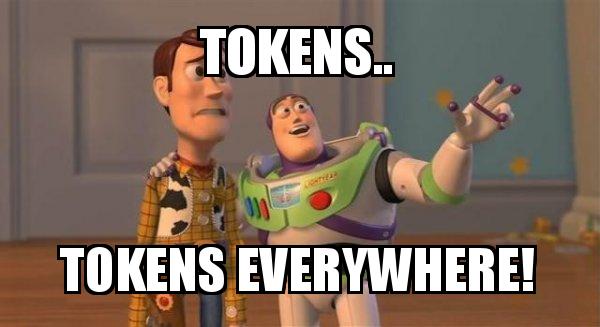Talent and money are flooding the digital currency market, and people are taking one side of the divide or the other, but the crypto world is, well, simply cryptic to most people. When you finally manage to warp your head around the basics, you miss the days when security engineering and forensic accountancy were separate fields. You end up feeling like the tail is wagging the dog when trying to distinguish between two almost similar terms – coins and tokens.
Differentiating cryptocurrency and coins vs. tokens may seem like nitpicking, but knowing the difference will help you better understand digital assets because an investment in knowledge pays the best interest.

Introduction
Ignorance was pure bliss back then when Bitcoin (BTC) was the only crypto asset, as no one had reason to distinguish digital assets. Nonetheless, trouble started in paradise in 2015 when Ethereum (ETH) launched, and a new class of digital assets called digital tokens came in. Most people misunderstand coins and tokens, believing they’re the same; nothing could be further from the truth. While both are units of digital assets, they have entirely different functionalities.
Tokens differ from coins created on their native blockchains; they exist on pre-existent smart contract blockchains. We tell you the difference since cryptocurrency terminology may not always be straightforward and at the end of the day, it’s not whether you’re right or wrong that’s matters, but how much wealth you create when you’re right and how much you lose when you’re wrong.
Coins: The Backbone of the Crypto Market
A crypto coin is a digital asset that’s native to its blockchain. For example, BTC is native to the Bitcoin blockchain, while ETH is native to the Ethereum network. Coins don’t rely on separate blockchain protocols since the developers build them into the blockchain’s foundational code. Crypto coins act as a store of value, and just like traditional money, they can be used as a medium of exchange, and it’s the reason they’re mostly called cryptocurrencies. One distinctive feature that cuts across all crypto coins is the system used to create them. Coins are mostly earned using Proof-of-Stake (PoS) mechanism or mined using Proof-of-Work (PoW) mechanism.
Bitcoin and other crypto coins were initially created as a potential replacement for traditional government fiat currencies. They’re designed to operate like your regular paper money and metal, meaning you can use them to pay for goods and services like the USD, EUR or other local currencies.
Apart from conventional uses, a few cryptocurrencies can use smart contracts to offer additional use cases. DASH is a perfect example of an altcoin that also operates as a crypto coin as it enables holders to cast their votes in Decentralized Autonomous Organizations (DAOs). Bitcoin, Litecoin, Ethereum and Dogecoin are prominent examples of crypto coins.
Read more: Trends and Performance of Major Cryptocurrencies
Tokens: Building on Existing Blockchains
Like crypto coins, tokens are also created on the foundation of blockchain technology but are not native to the blockchain they’re built on. Tokens are built on existing blockchains using smart contracts to perform their specific tasks. An excellent example of a token would be the FTT crypto, whose owners, cryptocurrency exchange FTX, created it as their platform’s utility asset.
Another example would be Axie Infinity’s utility token Smooth Love Potions (SLP), explicitly designed for use on the play-to-earn (P2E) market. Players who earn or buy SLP get exclusive rights to access in-game challenges. While crypto tokens can imitate traditional fiat currencies, you could say that crypto tokens resemble assets. For example, tokens could represent ownership shares in DAOs, digital products, physical objects or non-fungible tokens (NFTs). While it’s possible to buy, sell or exchange tokens just like coins, you can’t use tokens as a medium of exchange. You may want to compare crypto tokens with vouchers or coupons, while crypto coins are comparable to traditional monies.
Read more: Harry Styles’ EVNTZ App: The Future of Concerts?

While it’s possible to release crypto tokens on any network, blockchain developers mostly prefer the Ethereum blockchain. Tokens started coming into existence when Ethereum introduced the smart contract technology – smart contracts facilitate the easy development of Decentralized Applications (DApps) via blockchains like Ethereum. Most Ethereum-based DApps list their tokens for multiple uses within their ecosystems. When it comes to Ethereum, the tokens mostly adapt token standards that are called ERC-20. Among the most popular tokens include Aave, Uniswap and Chainlink.
Technology and Architecture Differences
Crypto coins operate on an independent network, and developers must create a new blockchain and enlist the correct infrastructure to launch a new coin. A crypto coin will continue to exist as long as its native blockchain remains online. The value of coins can be speculative, but it will stay as long as the native blockchain maintains users, miners and validators who keep the system up and running.
On the other hand, Tokens are designed on another network and are managed using software in blockchain technology called smart contracts. As a result, tokens cannot minus the underlying infrastructure provided by the foundational blockchain. To clarify, consider when paying for a new home with a mortgage or money, but you need a deed to prove ownership. However, the deed can’t exist without the underlying monetary system. In this case, your money may be the coin, while the deed would be the token.
Read more: Altcoins: Exploring the World of Alternative Cryptocurrencies
Tokenomics and Value Propositions
Tokenomics, a blend of token and economics, refers to the monetary rules and policies governing a crypto coin or token. Tokenomics comprise supply and circulation, besides determining how holders can earn. Tokenomics also influence the use and value of tokens – for example, NFTs are a one-of-a-kind token that incentivizes holders to create value based on scarcity or rarity.
A coin or token’s tokenomics and value proposition are outlined in a project’s whitepaper before release. Coins vs. tokens are also valued differently. BTC, the most valuable coin, currently has a market capitalization of $592 billion, while ETH stands at $229 billion. The price of coins, used as stores of value, is driven by the demand for the coin, while the demand of the underlying blockchain drives the price of tokens.
Investment and Risk Considerations
According to CoinMarketCap, the global cryptocurrency market cap stands at $1.19 trillion (at the time of writing). Still, it has gone to as high as $1.8 trillion (CoinMarketCap 2022), quite an achievement compared to gold’s market cap of $12.6 trillion. As a prospective investor, you want to determine whether the coin vs. token you desire is a sub-token or a stand-alone crypto such as Bitcoin.
Making a proper distinction will show whether or not the digital asset in question carries the parent company’s monetary security or policy. You must ensure the digital asset is mooning and isn’t a candidate for avoidable difficulties, crashes or termination. Tokens may be outstanding for new projects, but since they depend on the parent blockchain, there’s always an inherent risk based on the nature of the parent blockchain. Tokens, therefore, pose a relatively more significant risk than coins for the investor. It’s, therefore, your responsibility to conduct a risk assessment before investing your hard-earned cash in any digital asset, but remember, the biggest risk of all is not taking one.
Real-World Use Cases
Crypto coins have a variety of real-world use cases because they imitate precious metals and fiat currencies – it’s the reason they can be used to pay for goods and services or exchange value with family and friends via cryptocurrency wallets. Numerous businesses accept crypto payments; you can withdraw cash from Bitcoin ATMs, while countries like the Central African Republic and El Salvador have made Bitcoin legal tender.

Tokens also have a fiat value on NFT markets and cryptocurrency exchanges. While their real-world use cases include being an alternative medium of exchange, crypto tokens have many other use cases. The most common ones include wrapped tokens (synthetic copies of underlying cryptos on alternative blockchains), stablecoins (technical crypto tokens that track the price of USD, precious metals etc., USDT and USDC are the most common ones) and NFTs.
To Sum Things Up
Defining coins vs. tokens may have sounded like rocket science when we started, but now you can enjoy the ride because you know where it’s heading.
- A coin is on its native blockchain, while a token is created on a different blockchain.
- All coins may technically be tokens, but not all tokens can operate as coins.
- Coins are used as a means of exchange or an investment vehicle, but tokens correspond to specific projects or applications.

While crypto coins vs. tokens are the bolts and nuts of the digital asset economy, coins are considered safer and a more stable investment option. On the other hand, dealing with tokens may feel like you’re sitting on pins and needles, unpredictable and constantly changing, here today, gone tomorrow, without predominantly affecting other cryptocurrencies.
Now that the cat’s no longer in the hat, there’s no reason to sit on the fence. Get on board or get out of the way based on your research on whether your coin vs. token has diamond or paper hands.
Disclaimer: All materials on this site are for informational purposes only. None of the material should be interpreted as investment advice.Please note that despite the nature of much of the material created and hosted on this website, HODL.FM is not a financial reference resource and the opinions of authors and other contributors are their own and should not be taken as financial advice. If you require advice of this sort, HODL.FM strongly recommends contacting a qualified industry professional.
